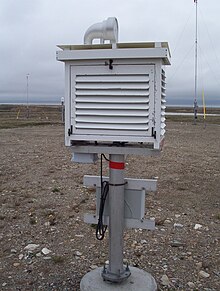
Back قفص ستيفنسون Arabic Garita meteorològica Catalan Thermometerhütte German Μετεωρολογικός κλωβός Greek Abrigo meteorológico Spanish Eguraldi-etxola Basque جعبه اسکرین Persian Abri Stevenson French Scáthlán Stevenson Irish Layar Stevenson Hausa

A Stevenson screen or instrument shelter is a shelter or an enclosure used to protect meteorological instruments against precipitation and direct heat radiation from outside sources, while still allowing air to circulate freely around them.[1] It forms part of a standard weather station and holds instruments that may include thermometers (ordinary, maximum/minimum), a hygrometer, a psychrometer, a dewcell, a barometer, and a thermograph.
Stevenson screens may also be known as a cotton region shelter, an instrument shelter, a thermometer shelter, a thermoscreen, or a thermometer screen. Its purpose is to provide a standardised environment in which to measure temperature, humidity, dewpoint, and atmospheric pressure. It is white in color to reflect direct solar radiation.
- ^ "Stevenson Screen". Environment Canada. Archived from the original on 5 March 2008. Retrieved 4 December 2007.